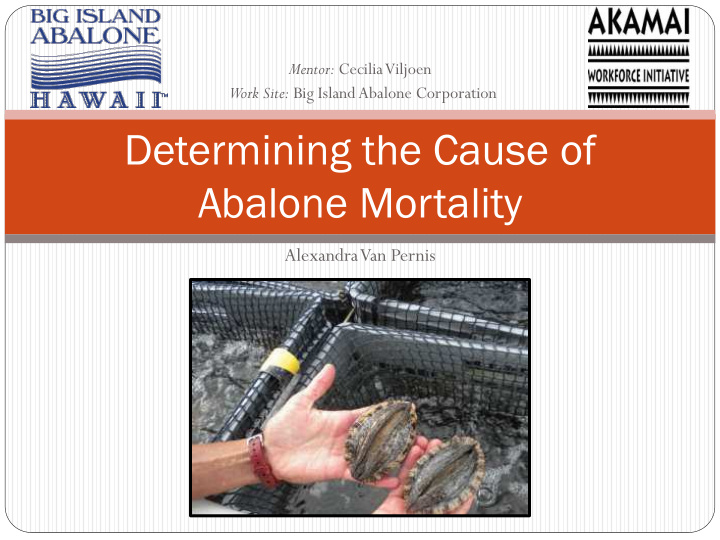



Mentor: Cecilia Viljoen Work Site: Big Island Abalone Corporation Determining the Cause of Abalone Mortality Alexandra Van Pernis
About t Big Islan land d Abalon one e Proje oject ct Backgr ground ound Corporation oration (BIA IAC) C) Periodic high mortality (80-90%) in 4-5 BIAC operates a 10-acre aquafarm, growing month-old abalone, generally correlated with and selling live abalone. It is located on the the full/new moon. Kona Coast at the Natural Energy Laboraty Mortality does not affect all tanks Hawaii Authority (NELHA) complex. simultaneously nor does it affect all tanks. They currently produce about 100 tons of live The abalone exhibit decreased movement abalone per year and sell them to vendors in and lose strength in their foot, but otherwise Hawaii, Japan and the Continental U.S. do not exhibit unusual characteristics.
Abou out t My Pr y Proj oject ect Two main parts: Test two tanks (chosen at random) containing a cohort of abalone that are four to five months old Test the tanks and abalone that experience mortality. A tank with light abalone mortality A tank with heavy abalone mortality
Tes esti ting ng Pa Parame rameter ers Effect ct on Abalone ne pH Water that is too acidic or too alkaline can kill the abalone. Dissolved Oxygen Low quantities of oxygen in the water can suffocate the abalone. Bacteria Swabs Presence of pernicious bacteria can kill the abalone or compromise their immune systems. Hemocytometer Protists or other organisms present in the incoming seawater can kill the abalone or compromise their immune systems. Parasite Parasites are known to target only specific subsets of abalone and can spread rapidly.
Res esul ults ts Pa Parame rameter ers Resu sults lts pH No significant changes. Dissolved Oxygen No significant changes. Bacteria Swabs Significant changes seen in quantity, both in the observable amount in the tank and the number of colonies cultured on plates. Hemocytometer Not enough cells to discern reliable results from. Parasite Organisms that could be parasites have been observed.
Ou Outc tcom omes: es: Ba Bact cter eria ia The amount of bacterial colonies seen on plates increased when comparing samples from infected and unifected tanks. The amount of bacteria visible to the naked eye also increased in infected tanks. It is unknown if this response contributes to Uninfected Infected the abalone mortality or if it is a byproduct. Uninfected Infected Uninfected Infected
Ou Outc tcom omes: es: Par aras asit ite Currently the parasite looks like the most promising cause of mortality. However this has not been definitely proven. Research shows that BIAC’s abalone exhibit characteristics consistent with infection by the L: Uninfected abalone Infected abalone “sitting up” away parasite Labyrinthuloides haliotidis . R: Infected abalone from the side of the tank These characteristics include the age of mortality, the high rates of mortality, the decreased foot strength and the lethargy. Suggested treatment methods include treating every liter of incoming seawater with 25mg of chlorine. Possible stained L. haliotidis from a Possible L. haliotidis in abalone live abalone sample tissue
Next xt Step eps Discern the latent period of abalone mortality: 50 abalone from an uninfected tank have been placed in an infected tank and separated. 50 abalone from an uninfected tank have been separated from the rest of their tank as a control. Test the treatment method for the parasite, if confirmed: 25mg of chlorine per 1 liter of sea water, treated for 20 minutes.
Ack ckno nowl wled edge gement ments Cecilia Big Island Abalone (and everyone who works there!) The Akamai Workforce Initiative, especially Lisa, Austin and Dr. J
Meth thod ods/ s/Appr Approach oach pH: Use a pH probe to measure the pH Hemocytometer: Screen incoming and of three separate locations near the effluent water with 5µm and 20µm and outtake valve of each tank and average 5µm screens respectively. Dilute with the values together to compute a 2ml of deep sea water (to preserve live representative pH. organisms trapped on the screen), stain cells and count and study under a Dissolved Oxygen (DO): Same microscope using a grid. approach as used for pH. Parasite: If abalone mortality occurs Bacteria Swabs: Swab the sides of the study the abalone under a microscope tank, near the outtake valve, and to look for signs of parasite presence. culture on both Thiosulfate-citrate-bile salts-sucrose agar ( TCBS) and Marine agar plates. Subculture on ChromAgar plates to further discern bacterial types.
Maj ajor or Mil ilest eston ones es Sampling occurs every Wednesday and there will be 5 sample days. Two of those samples have been taken. Abalone mortality in a 4-5 month-old cohort will be used to determine parasite presence.
Recommend
More recommend